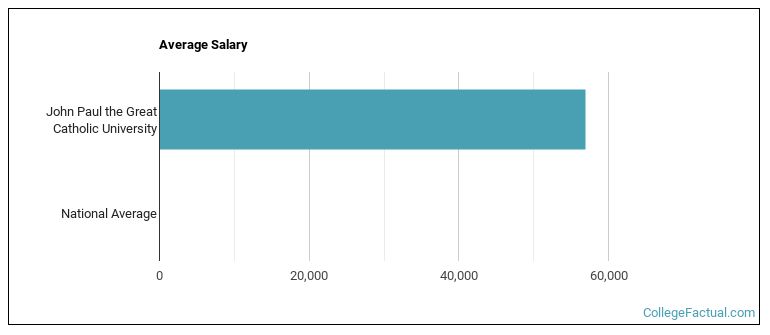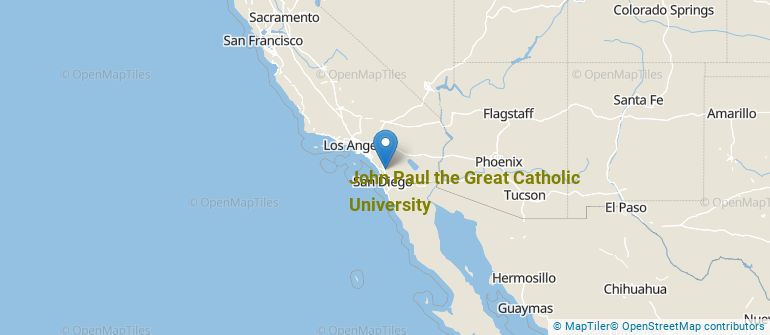 by our College Data Analytics Team
by our College Data Analytics TeamExplore the best ranked schools for the programs you are most interested in.
JPCatholic was not ranked in College Factual's Best Overall Colleges report this year. This may be because not enough data was available.
See all of the rankings for John Paul the Great Catholic University.
When it comes to admittance, John Paul the Great Catholic University is somewhat selective. Its acceptance rate is 80%, which means you'll face some strong competition during the admissions process. Do what you can to make your application stand out.
About 26% of students accepted to JPCatholic submitted their SAT scores. When looking at the 25th through the 75th percentile, SAT Evidence-Based Reading and Writing scores ranged between 540 and 574. Math scores were between 520 and 551.
Learn more about John Paul the Great Catholic University admissions.
The student to faculty ratio at John Paul the Great Catholic University is about average at 18 to 1. This ratio is often used to gauge how many students might be in an average class and how much time professors will have to spend with their students on an individual level. The national average for this metric is 15 to 1.
When estimating how much access students will have to their teachers, some people like to look at what percentage of faculty members are full time. This is because part-time teachers may not have as much time to spend on campus as their full-time counterparts.
The full-time faculty percentage at John Paul the Great Catholic University is 31%. This is lower than the national average of 47%.
The freshmen retention rate of 84% tells us that most first-year, full-time students like John Paul the Great Catholic University enough to come back for another year. This is a fair bit higher than the national average of 68%. That's certainly something to check off in the good column about the school.
The on-time graduation rate for someone pursuing a bachelor's degree is typically four years. This rate at JPCatholic for first-time, full-time students is 53%, which is better than the national average of 33.3%.
Find out more about the retention and graduation rates at John Paul the Great Catholic University.
During the 2017-2018 academic year, there were 274 undergraduates at JPCatholic with 256 being full-time and 18 being part-time.
| $0-30 K | $30K-48K | $48-75 | $75-110K | $110K + |
|---|---|---|---|---|
| $24,062 | $24,607 | $25,663 | $31,757 | $36,472 |
The net price is calculated by adding tuition, room, board and other costs and subtracting financial aid.Note that the net price is typically less than the published for a school. For more information on the sticker price of JPCatholic, see our tuition and fees and room and board pages.
While almost two-thirds of students nationwide take out loans to pay for college, the percentage may be quite different for the school you plan on attending. At JPCatholic, approximately 67% of students took out student loans averaging $7,131 a year. That adds up to $28,524 over four years for those students.
Get more details about paying for John Paul the Great Catholic University.

See which majors at John Paul the Great Catholic University make the most money.
Get more details about the location of John Paul the Great Catholic University.

Contact details for JPCatholic are given below.
| Contact Details | |
|---|---|
| Address: | 155 W. Grand Ave, Escondido, CA 92025 |
| Phone: | 858-653-6740 |
| Website: | https://jpcatholic.edu/ |
| Facebook: | https://www.facebook.com/JPCatholic |
| Twitter: | https://twitter.com/JPCatholic |
| Most Popular Majors | Bachelor’s Degrees | Average Salary of Graduates |
|---|---|---|
| Communication & Media Studies | 48 | NA |
| Liberal Arts General Studies | 8 | NA |
| Business Administration & Management | 7 | NA |
Footnotes
*The racial-ethnic minorities count is calculated by taking the total number of students and subtracting white students, international students, and students whose race/ethnicity was unknown. This number is then divided by the total number of students at the school to obtain the racial-ethnic minorities percentage.
References
More about our data sources and methodologies.